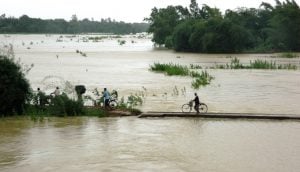In 2007, the Yellow river dried up: for 277 days it failed to reach the sea, its lower reaches reduced to a broad highway of cracked mud. The Yellow river begins its 3,000-mile journey on the high Qinghai Tibet plateau and meanders across north China until it reaches the Bohai Gulf. It is celebrated as China’s mother river because of the state-sponsored claim that Chinese civilisation began in the fertile soils of its middle reaches. That it should have dried up for most of a year, therefore, carried a significance far beyond the immediate environmental catastrophe.
As Philip Ball describes in The Water Kingdom, managing China’s huge and troublesome rivers has been the job of the ruler since earliest times. The mythical Emperor Yu auditioned for the top post by taming the floods 4,000 years ago. Successive empires and countless officials have risen and fallen on the quality and effectiveness of their hydrology and ambitious engineering has drained the coffers of many dynasties in a culture in which competence in water management is seen as a proxy for fitness to rule.
One school of Chinese history has argued that the very shape and nature of the Chinese state was determined by the need for water control projects – dams, levees, canals and diversions – that demanded the coercive mobilisation of the labour of millions of people down the centuries. Water is essential to all civilisations, but in China the relationship between culture, philosophy, state formation and hydrology is uniquely close.
Flood and drought could bring down dynasties, and even poets and philosophers debated the best way to manage water: the Daoist tradition favoured a light touch, drawing off the excess with canals and allowing the river to flood widely, depositing rich silt on the flood plain. Confucian officials inclined towards more interventionist engineering, with higher, narrower dykes. Each approach had its successes and failures.
The scale of China’s hydrology throughout history has been as breathtaking as the difficulties and disasters it engenders: China’s rainfall is disproportionately abundant south of the Yangtze, but scarce in the north. In north China, the Yellow river dominates – a river that, because of its massive silt load, has a way of defying attempts to bring it to heel. Dykes that were built higher and higher as the river bed rose could rupture and bring catastrophic flooding over huge areas, as did the floods in Henan province in 1886, which killed up to an estimated 2.5 million people. In modern times, many attempts to control the river with dams were defeated by silt, and today, with a legacy of over-extraction, degradation of the headwaters, pollution and climate change, the river is facing a different set of crises.
Ball’s journey along the history, politics and culture of China’s waterways encompasses many heroes of Chinese hydrology, men who grappled with elemental forces and imperial censure and sometimes came out on top. Equally dramatic is his account of riverine warfare, a lesser-known tradition than the sea voyages of the Ming eunuch admiral Zheng He, with his 10-masted treasure ships, 1,500-ton floating fortresses that dwarfed anything Europe produced.
Ming dynasty and the rebellion troops led by Li Zicheng, not the incoming Manchu.
China’s rivers were not only theatres of war – they were also, notoriously, used as a weapon of war: in 1642, in a battle between the Ming dynasty and a rebel army led by Li Zicheng, Yellow river dykes were breached by both sides, creating a catastrophe for Kaifeng in which 300,000 of its 378,000 citizens died. In the 20th century, the retreating KMT general Chiang Kai-shek breached the Yellow river defences to slow the advancing Japanese forces, with devastating results.
But it is the engineering that continues to dominate the story: the Grand Canal, begun in the 7th century under the short-lived Sui dynasty, was essential for the transport of grain from the south to the northern capital, the coast routes being too uncertain and pirate infested. By the middle of the 18th century, half of Beijing’s grain came from the south and up to 20% of the revenues of the Qing dynasty (1644-1911) were swallowed by the demands of the Grand Canal.
When the Qing dynasty began to weaken, it abandoned the canal, and the unemployed boatmen diverted their energies into secret societies that engaged in organised crime and in plots against the emperor. Some of them were recruited by a failed Confucian scholar who came to believe himself the young brother of Jesus Christ, raising a rebellion that lasted 10 years and cost nearly 30 million lives.
When the Communist party emerged victorious from China’s brief civil war in 1949, it, too, found itself obliged to take up the mantle of managing China’s rivers. It was a role that appealed to Mao Zedong, who believed that conquering nature was essential to the construction of socialism, and who militarised Chinese society through a series of “wars” against nature, the disastrous consequences of which still hang over China’s future. In an irrigation campaign in the Yellow river between 1957 and 1959, the party increased the rate of extraction from the river by an astonishing 83 times, while succeeding in reducing the crop yield.
By the time Mao had finished, 80,000 dams had been built, many by peasants equipped with little more than the all-conquering thoughts of the Chairman. More than 500 of them collapsed in 1973 alone and by 1980, 3,000 had given way. It was in 1975, the year before Mao’s death, that China suffered the most catastrophic dam collapse in history, when Typhoon Nina caused the Banqiao dam in Henan to give way, releasing 700m cubic metres of water that travelled at some 40 miles an hour, devastating everything in its path. Nearly a quarter of a million people are estimated to have died in the inundation and its long aftermath of disease and exposure. The catastrophe was kept a closely guarded secret for more than 30 years and the officials in charge were promoted.
Mao’s successors were, if anything, even more enthusiastic about water engineering, though mercifully more inclined to respect engineering expertise. The controversial Three Gorges dam, pushed through the National People’s Congress in the aftermath of the Tiananmen massacre, continues to engender the problems that its critics predicted it would bring. Popular resistance to dam building has slowed, but not stopped some high-profile projects, though China’s big hydro companies are now intent on damming important trans-boundary rivers (the Brahmaputra and the Mekong among others) without consulting the people downstream who depend on them.
Meanwhile, nearly four decades of headlong industrialisation has left China’s water resources in a parlous condition. In 2012, China’s first national water census, which Ball, curiously, does not mention, revealed that more than 28,000 rivers – just under half – had disappeared in the past 20 years. All the remaining rivers of north China are suffering from over extraction; ground water is both polluted and depleted, and 300 million people have no access to safe drinking water. (One contributing factor surprisingly absent from Ball’s otherwise thorough account is the role of coal, which consumes approximately 20% of China’s fresh water).
Ball argues that China’s future, like the past, can be read in the fate of its water. Certainly north China is in big trouble, with a deepening water deficit that even the most recent engineering effort, the South-North Water Diversion project, is unlikely to fix. He finds encouragement in the appearance of non-governmental environmental groups, and notes the emergence of liberal voices in the water discussion. Unfortunately, the pendulum has begun to swing the other way, with increased authoritarianism and a centralisation of power under party secretary Xi Jinping. Whether his methods will succeed in solving China’s water woes, history will judge.
The Water Kingdom is published by Bodley Head. The article was first published on the Guardian.









